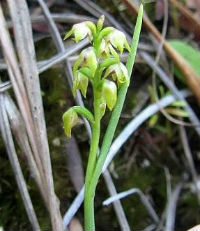Uncommon orchid found

In a recent visit members of the Auckland Botanical Society identified a native orchid growing in the Park. Corunastylis pumila is a tiny orchid which is described as being naturally uncommon and easily overlooked because of its small size and autumn flowering.It is most often recorded from Northern North Island south to about Kawhia, East Cape and Bay of Plenty.
It requires open, sparsely vegetated and relatively unfertile habitats such as gumland scrub. Habitats which are artificially maintained such as track and roadsides are a possible location, often in regenerating Kauri forest.

